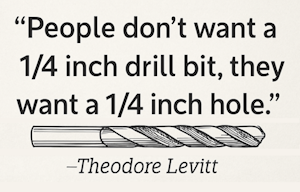Jobs-To-Be-Done Framework
Build what people truly need by understanding the job they're hiring your product to do.
"The key is to understand the struggle and make the customer's life better—not just to sell them a product."
The Jobs-to-be-Done (JTBD) framework evolved as a response to traditional demographic or persona-based approaches that often missed the underlying motivations of customer behavior. Popularized by Clayton Christensen and Tony Ulwick,1 JTBD views customers not as buyers of products, but as people "hiring" products to get a specific job done in their life. For Agile teams and organizations, this mindset shift is profound, it reorients product thinking away from features and toward outcomes. Agile becomes a vehicle not only for building software but for solving real, meaningful problems through customer value.

Impact on Agile Organizations
When Agile teams internalize JTBD, they become more customer-centric and outcome-focused. This has several ripple effects across planning, delivery, and learning cycles.
- Backlog Refinement and Prioritization:
- Stories become anchored in user needs instead of system functions.
- Prioritization improves by aligning work to high-value customer jobs.
- Cross-functional Collaboration:
- Developers, designers, and product managers collaborate around context, not just tasks.
- Shared language about "jobs" increases alignment across teams
- Validation and Feedback Loops:
- User interviews and testing focus on understanding unmet needs and job success.
- Continuous feedback reveals whether a job was truly completed, rather than whether a feature was shipped.
- Strategic Decision-Making:
- Product strategy is driven by jobs worth solving, not just market segments.
- Helps avoid "solutioneering" and premature feature development.
Scenario
A product team working on a meal-planning app was focused on adding more recipes, thinking variety was the key to engagement. They had a well-groomed backlog filled with features like advanced filters, ingredient substitution, and seasonal menus. Despite shipping regularly, engagement metrics were flat.
After adopting JTBD thinking, they interviewed users and discovered the real job was, "Help me feel confident I can feed my family something healthy, even when I'm busy and stressed". The team pivoted their roadmap to emphasize meal prep automation, leftover suggestions, and stress-reducing UX flows.
- The original features were useful, but only partially addressed the core job.
- Users didn't want more choices; they wanted fewer decisions.
- Engagement increased once the product aligned with this emotional and functional job.
JTBD gave the team clarity about what problem they were really solving, and why users would care.
Ways to Mitigate Misuse or Misalignment:
Applying JTBD effectively requires care. Without structure, teams may fall into fuzzy customer research or lose momentum between discovery and delivery.
- Clarify the Job Context:
- Identify situations, motivations, and desired outcomes.
- Distinguish functional jobs from emotional and social dimensions.
- Integrate JTBD with Agile Artifacts:
- Use jobs as context in epics and user stories.
- Align Definition of Done with job success metrics.
- Balance Discovery and Delivery:
- Ensure sprint work reflects jobs that are currently validated or being tested.
- Use jobs as hypotheses to guide short feedback loops.
- Reframe Metrics and Roadmaps:
- Track job success indicators instead of feature release counts.
- Build roadmaps that solve prioritized jobs, not just push technical capabilities.
Conclusion:
JTBD reframes Agile practice from output delivery to outcome impact. It shifts product thinking from what users say they want to what they are trying to accomplish. For Agile teams, this alignment opens the door to more meaningful iterations, more focused prioritization, and ultimately more successful products. The discipline of JTBD is not a replacement for Agile, it deepens it by giving teams a stronger anchor to user purpose.
Key Takeaways
- JTBD helps Agile teams focus on outcomes instead of features.
- It improves backlog prioritization by surfacing real customer needs.
- Teams become more aligned around context, not just tasks.
- Validation loops shift from feature testing to job success.
- Effective use requires structured research and careful integration into Agile routines.
Summary
The Jobs-to-be-Done framework brings clarity to Agile teams by focusing on the real problems users are trying to solve. It bridges strategy and delivery, helping teams prioritize what matters most to customers. By embedding JTBD into user stories, validation cycles, and product planning, Agile teams can create not just working software, but truly helpful solutions.